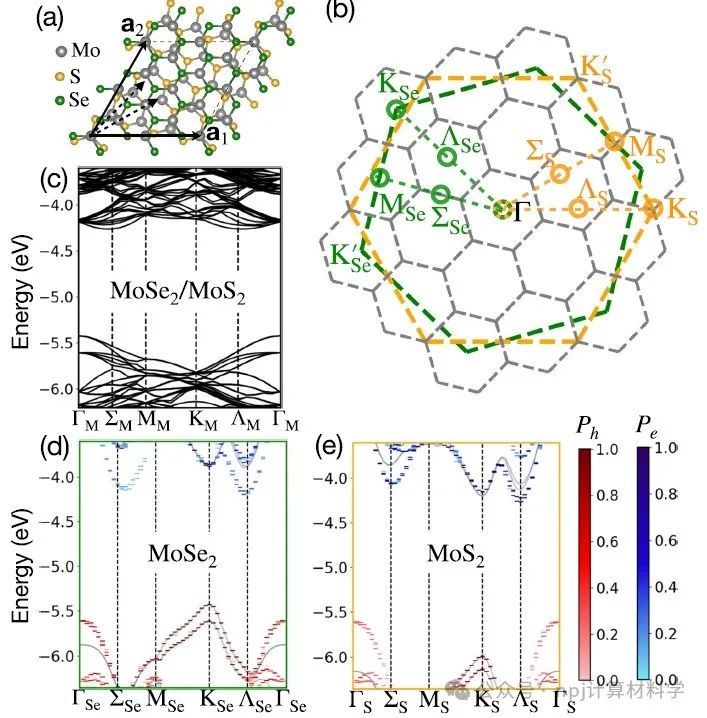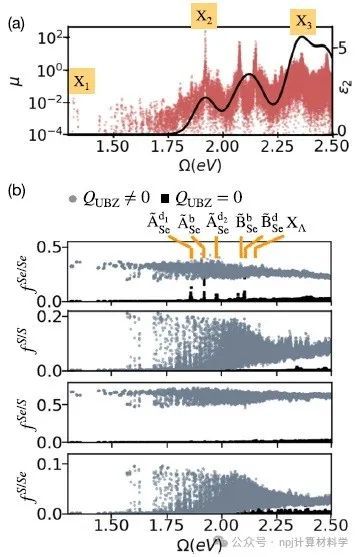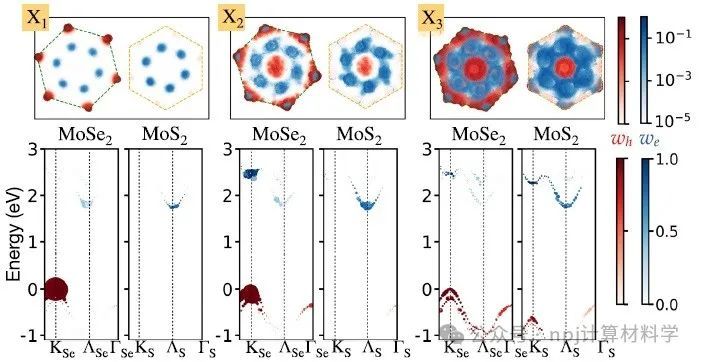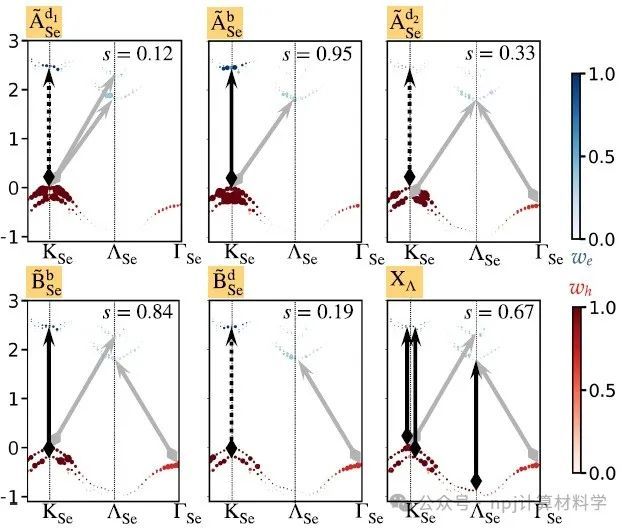二维材料层间晶格不匹配产生的莫尔图案为新型电子和激子物理提供了一个崭新平台。特别具有类型-II能带对齐的过渡金属二硫化物(TMD)转角异质结构,由于转角引起的莫尔势导致了激子定域变化,从而呈现出了有趣的光学特性。

Fig. 1 Atomic structure, momentum-space representation, and electronic band structures of the examined heterostructure.
层间转角角度决定了莫尔布里渊区(MBZ)与单层晶胞布里渊区(UBZs)之间的关联,引发了相关的莫尔势。这导致了在UBZs中具有不同动量态之间的光允许电子–空穴跃迁,这可能与吸收过程中激子的精细结构有关。为了对激子结构与转角角度之间关系进行全面理解,需要对转角结构中的激子进行基于GW-BSE的多体微扰理论分析。

Fig. 2 Absorption spectrum and exciton components.
来自印度科学研究所物理系凝聚态理论中心的Sudipta Kundu等,提出了一种使用GW-BSE研究TMD异质结中双层转角角度对激子性质和光学选择规则影响的方法。作者在一个相对旋转角度为16∘的转角MoS2/MoSe2异质结构上演示了其方法,该结构允许在UBZs中不同高对称点之间发生跃迁,由原子重构和层间不匹配确定。通过分析,作者揭示了一种独特的动量混合激子性质,其状态由层间和层内电子–空穴激发组成。

Fig. 3 Unfolded excitons and dominant band contributions.
这些结果指出了动量直接激子和光学活跃激子的一般性质,其混合了层UBZs中的不同点,并且在较小的角度下同样有效。这一结果表明,激子性质和光谱特征与转角的TMD异质结构的底层结构之间存在直接的关系,可为通过选择层间转角角度来调节激子性质提供了潜在可能性。该文最近发布于npj Computational Materials 9: 186 (2023).

Fig. 4 Analysis of the excitonic states with dominant contributions from the MoSe2 intralayer excitations
Editorial Summary
Exciton Behaviors in twisted TMD heterostructures
Moiré patterns generated due to a lattice mismatch between layers of two-dimensional materials serve as an emerging platform for novel correlated electronic and excitonic physics. In particular, twisted heterostructures of transition metal dichalcogenides (TMDs) with a type-II band alignment hold intriguing optical properties due to the varying exciton localization associated with the twist-induced moiré potential. The interlayer twist angle dictates the relation between the moiré Brillouin Zone (MBZ) and the unit-cell Brillouin Zones (UBZs) of the separate layers, inducing an associated moiré potential. This leads to optically-allowed electron-hole transitions between states of different momenta in the UBZs, which can be associated with the exciton fine structure in absorption. A full GW-BSE based many-body theory analysis of excitons in the twisted structure is required for a general ab initio understanding of the relation between the twist angle and the exciton structure.
Sudipta Kundu et al. from the Centre for Condensed Matter Theory, Department of Physics, Indian Institute of Science, presented an approach to study the effect of twist angle on the exciton nature and optical selection rules in TMD hetero-bilayers by using GW-BSE. They demonstrated their approach on a twisted MoS2/MoSe2heterostructure with a relative rotation angle of 16°, which allows transitions between distinct high-symmetry points in the UBZs, determined by the atomic reconstruction and interlayer mismatch. Analyses reveal a unique momentum-mixed excitonic nature, with states that are comprised of both inter- and intra-layer electron-hole excitations. These results point to a general property of momentum-direct and optically-active excitons that mix different points in the layer UBZs, and is valid at smaller angles as well. Their findings suggest a direct relation between exciton nature and spectral features to the underlying structure in twisted TMD heterostructures, offering potential tunability of excitonic properties upon the choice of interlayer twist angle. This article was recently published in npj Computational Materials 9: 186 (2023).
原文Abstract及其翻译
Exciton fine structure in twisted transition metal dichalcogenide heterostructures (转角过渡金属硫化物异质结构中的激子精细结构)
Sudipta Kundu, Tomer Amit, H. R. Krishnamurthy, Manish Jain & Sivan Refaely-Abramson
Abstract
Moiré superlattices of transition metal dichalcogenide (TMD) heterostructures give rise to rich excitonic phenomena associated with the interlayer twist angle. Theoretical calculations of excitons in such systems are typically based on model moiré potentials that mitigate the computational cost. However, predictive understanding of the electron-hole coupling dominating the excitations is crucial to realize the twist-induced modifications of the optical selection rules. In this work, we use many-body perturbation theory to evaluate the relation between twist angle and exciton properties in TMD heterostructures. We present an approach for unfolding excitonic states from the moiré Brillouin zone onto the separate-layer ones. Applying this method to a large-angle twisted MoS2/MoSe2 bilayer, we find that the optical spectrum is dominated by mixed electron–hole transitions with different momenta in the separate monolayers, leading to unexpected hybridization between interlayer and intralayer excitons. Our findings offer a design pathway for exciton layer-localization in TMD heterostructures.
摘要
过渡金属硫化物(TMD)异质结构的莫尔超晶格引起了与层间转角相关丰富的激子现象。此类系统中激子的理论计算通常基于模型莫尔势,从而降低计算成本。然而,对主导激发的电子–空穴耦合的预测性理解,对于实现光学选择规则扭转引起的修改至关重要。在本工作中,我们使用多体微扰理论评估了TMD异质结构中的转角和激子性质之间的关系。我们提出了一种从莫尔布里渊区展开激子态到单独层的方法。将这种方法应用于大角度扭曲的MoS2/MoSe2双层,我们发现,光谱主要由在单独单层中具有不同动量的混合电子–空穴跃迁主导,导致层间和层内激子之间的意外杂化。我们的发现为TMD异质结构中的激子层定位提供了设计途径。










 研究者通过GW-BSE理论探讨了转角过渡金属二硫化物(TMD)异质结构中,转角角度如何影响激子性质和光学选择规则。发现混合电子–空穴激子在大角度扭曲的结构中表现出独特的层间和层内杂化特性,这为通过调控层间转角来调节激子性质提供了可能。
研究者通过GW-BSE理论探讨了转角过渡金属二硫化物(TMD)异质结构中,转角角度如何影响激子性质和光学选择规则。发现混合电子–空穴激子在大角度扭曲的结构中表现出独特的层间和层内杂化特性,这为通过调控层间转角来调节激子性质提供了可能。

















 被折叠的 条评论
为什么被折叠?
被折叠的 条评论
为什么被折叠?








